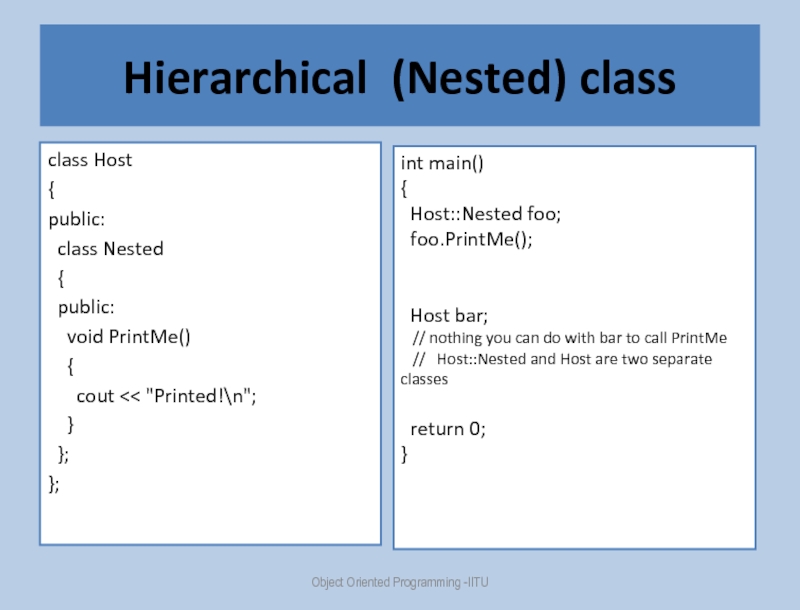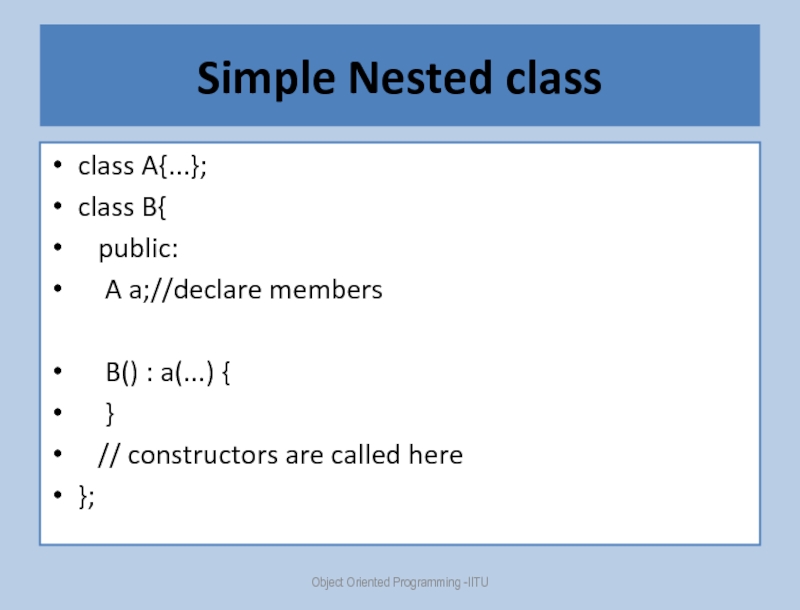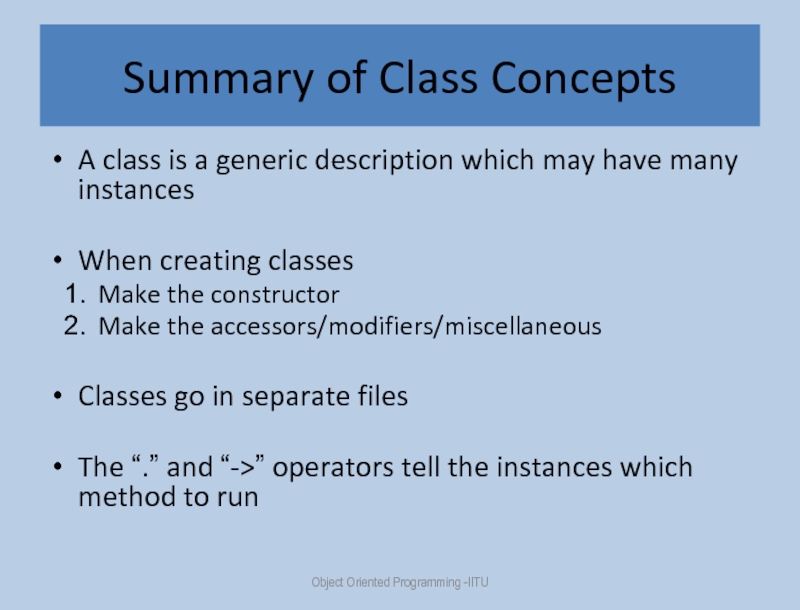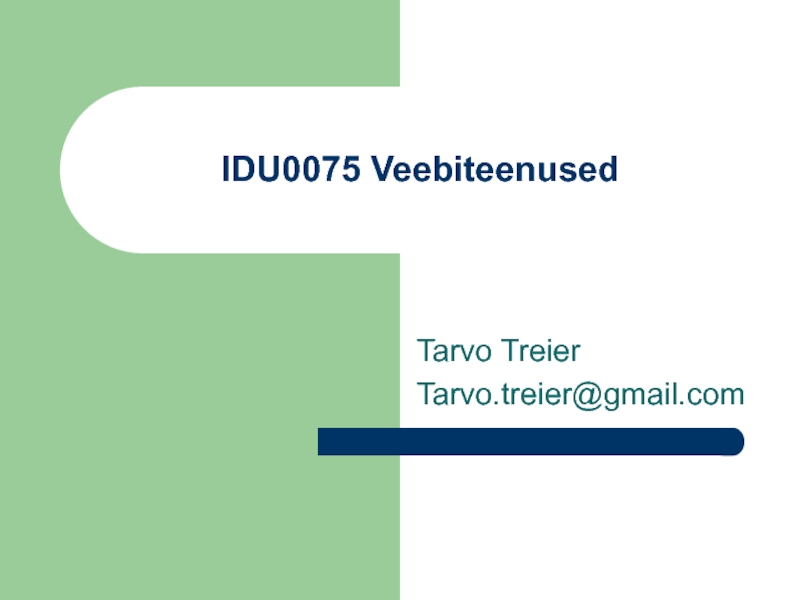- Главная
- Разное
- Дизайн
- Бизнес и предпринимательство
- Аналитика
- Образование
- Развлечения
- Красота и здоровье
- Финансы
- Государство
- Путешествия
- Спорт
- Недвижимость
- Армия
- Графика
- Культурология
- Еда и кулинария
- Лингвистика
- Английский язык
- Астрономия
- Алгебра
- Биология
- География
- Детские презентации
- Информатика
- История
- Литература
- Маркетинг
- Математика
- Медицина
- Менеджмент
- Музыка
- МХК
- Немецкий язык
- ОБЖ
- Обществознание
- Окружающий мир
- Педагогика
- Русский язык
- Технология
- Физика
- Философия
- Химия
- Шаблоны, картинки для презентаций
- Экология
- Экономика
- Юриспруденция
C++ Classes How to Create and Use Them (Constructor, Destructor) презентация
Содержание
- 1. C++ Classes How to Create and Use Them (Constructor, Destructor)
- 2. Overview Functions in Classes (methods) Constructor Accessors/Modifiers
- 3. Class Constructors A class constructor is
- 4. Specification of TimeType Class Constructors
- 5. Implementation of TimeType Default Constructor
- 6. Implementation of Another TimeType Class Constructor
- 7. Automatic invocation of constructors occurs
- 8. The Class Destructor A destructor is a
- 9. Destructor example CDog ::~CDog (void) { cout
- 10. A “real life” example The CDog Attributes
- 11. Step 1: The Skeleton class CDog {
- 12. Step 2: The attributes class CDog
- 13. Step 3: The Constructor This is a
- 14. Step 3: Designing the Constructor Constructors will
- 15. Step 3: The Constructor class CDog {
- 16. Back to CDog class CDog { public:
- 17. Miscellaneous Methods Follow the pattern void CDog::eat ( ) { cout
- 18. Add Methods class CDog { public: boolean
- 19. Create New Object(Instance) Cdog c1 ;
- 20. The “.” and “->” operators “Dot” operator
- 21. Using the “.” and “->” Operators #include
- 22. Accessors and Modifiers Accessor for the rabid
- 23. Using accessors and modifiers #include
- 24. Make a Separate Header File (for the
- 25. Our Final CDog.cpp #include
- 26. Hierarchical (Nested) class class Host { public:
- 27. Simple Nested class class A{...}; class B{
- 28. Summary of Class Concepts A class is
Слайд 2Overview
Functions in Classes (methods)
Constructor
Accessors/Modifiers
Miscellaneous
Terminology
File Topology
Designing Classes
The Driver and Object instantiation
Object Oriented
Слайд 3Class Constructors
A class constructor is a member function whose purpose
The name of a constructor is always the name of the class, and there is no return type for the constructor
A class may have several constructors with different parameter lists. A constructor with no parameters is the default constructor
A constructor is implicitly and automaticly invoked when a class object is declared--if there are parameters, their values are listed in parentheses in the declaration
Object-oriented programming - IITU
Слайд 4
Specification of TimeType Class Constructors
class TimeType // timetype.h
{
public : // 7
void Set ( int hours , int minutes , int seconds ) ;
void Increment ( ) ;
void Write ( ) const ;
bool Equal ( TimeType otherTime ) const ;
bool LessThan ( TimeType otherTime ) const ;
TimeType ( int initHrs , int initMins , int initSecs ) ; // constructor
TimeType ( ) ; // default constructor
private : // 3 data members
int hrs ;
int mins ;
int secs ;
} ;
Object-oriented programming - IITU
Слайд 5
Implementation of TimeType Default Constructor
TimeType :: TimeType ( )
// Default
// Postcondition:
// hrs == 0 && mins == 0 && secs == 0
{
hrs = 0 ;
mins = 0 ;
secs = 0 ;
}
Object-oriented programming - IITU
Слайд 6
Implementation of Another TimeType Class Constructor
TimeType :: TimeType (int
// Constructor
// Precondition: 0 <= initHrs <= 23 && 0 <= initMins <= 59
// 0 <= initSecs <= 59
// Postcondition:
// hrs == initHrs && mins == initMins && secs == initSecs
{
hrs = initHrs ;
mins = initMins ;
secs = initSecs ;
}
Object-oriented programming - IITU
Слайд 7
Automatic invocation of constructors occurs
Main(){
TimeType departureTime ;
TimeType movieTime (19, 30, 0 ) ; // parameterized constructor
departureTime movieTime
}
Object-oriented programming - IITU
Private data:
hrs
mins
secs
Set
Increment
Write
LessThan
Equal
0
0
0
Private data:
hrs
mins
secs
Set
Increment
Write
LessThan
Equal
19
30
0
Слайд 8The Class Destructor
A destructor is a special member function of a
A destructor will have exact same name as the class prefixed with a tilde (~) and it can neither return a value nor can it take any parameters. Destructor can be very useful for releasing resources before coming out of the program like closing files, releasing memories etc.
Object Oriented Programming -IITU
Слайд 10A “real life” example
The CDog
Attributes (characteristics)
rabid or not rabid (bool)
weight (int
name (char [ ])
Behaviors
growl
eat
Object Oriented Programming -IITU
Слайд 11Step 1: The Skeleton
class CDog {
// attributes will go here –
// behaviors will go here – growl, eat
};
Object Oriented Programming -IITU
Слайд 12Step 2: The attributes
class CDog {
public:
boolean rabid;
int weight;
char name[255];
//
};
Object Oriented Programming -IITU
Слайд 13Step 3: The Constructor
This is a special function
Used to give initial
Is activated when someone creates a new instance of the class
The name of this function MUST be the same name as the class
Object Oriented Programming -IITU
Слайд 14Step 3: Designing the Constructor
Constructors will vary, depending on design
Ask questions:
Are
(yes – they are all born non-rabid)
Are all CDogs born with the same weight?
(no – they are born with different weights)
Are all CDogs born with the same name?
(no – they all have different names)
If ever “no”, then you need information passed in as parameters.
Object Oriented Programming -IITU
Слайд 15Step 3: The Constructor
class CDog {
public:
boolean rabidOrNot;
int weight;
char name [255];
// Constructor
CDog::CDog
{
rabid = false;
weight = x;
strcpy (name, y);
}
// Behaviors go here
};
Object Oriented Programming -IITU
Notice that every
CDog we create
will be born
non-rabid. The
weight and name
will depend on the
values of the
parameters
Слайд 16Back to CDog
class CDog {
public:
boolean rabidOrNot;
int weight;
char name [255];
// Constructor
CDog::CDog (int
rabid = false;
weight = x;
strcpy (name, y);
}
CDog ::~CDog ()
{ cout << "Object is being deleted" << endl; }
// Behaviors we still need to eat and growl
};
Object Oriented Programming -IITU
Слайд 17Miscellaneous Methods
Follow the pattern
void CDog::eat ( ) {
cout
weight++;
}
void CDog::growl ( ) {
cout << “Grrrr” << endl;
}
Object Oriented Programming -IITU
Слайд 18Add Methods
class CDog {
public:
boolean rabidOrNot;
int weight;
char name [255];
// Constructor
CDog::CDog (int x,
rabid = false;
weight = x;
strcpy (name, y);
}
void CDog::eat ( ) {
cout << name << “ is now eating” << endl;
weight++;
}
void CDog::growl ( ) {
cout << “Grrrr” << endl;
}
};
Object Oriented Programming -IITU
Слайд 19Create New Object(Instance)
Cdog c1 ; // create an object that run
CDog c2 (7, “Ethel”); // create an object that run other constructor
CDog* c1 = new CDog (14, “Bob”); // create a pointer object
Object Oriented Programming -IITU
Слайд 20The “.” and “->” operators
“Dot” operator used for non-pointers to:
Get to
Get to an instances methods
Basically get inside the instance
Format:
Arrow operator used for pointers
Format:
Object Oriented Programming -IITU
Слайд 21Using the “.” and “->” Operators
#include
void main ( ) {
CDog*
c1 = new CDog (14, “Bob”);
CDog c2 (7, “Ethel”);
c2.bark( );
c1->growl( );
}
Object Oriented Programming -IITU
Слайд 22Accessors and Modifiers
Accessor for the rabid attribute
bool CDog::getRabid ( ) {
return
}
Modifier for the rabid attribute
void CDog::setRabid (bool myBoolean) {
rabid = myBoolean;
}
Put these inside of the CDog class
Object Oriented Programming -IITU
Слайд 23Using accessors and modifiers
#include
void main ( ) {
CDog* c1;
c1 =
CDog c2 (7, “Ethel”);
c1->setRabid (1);
// prints 1 for true
cout << c1->getRabid( ) << endl;
}
Object Oriented Programming -IITU
Слайд 24Make a Separate Header File
(for the generic description)
class CDog {
public:
int weight;
bool
char name [ ];
CDog (int x, char y[ ]);
bool getRabid ( );
void setRabid (bool x);
char [ ] getName ( );
void setName (char z[ ]);
int getWeight ( );
void setWeight (int x);
void bark( );
void growl( );
};
Object Oriented Programming -IITU
Слайд 25Our Final CDog.cpp
#include
#include
// Constructor
CDog::CDog
rabid = false;
weight = x;
strcpy(name, y);
}
void CDog::eat ( ) {
cout << name << “ is eating”;
}
void CDog::growl ( ) {
cout << “Grrrr”;
}
Object Oriented Programming -IITU
bool CDog::getRabid ( ) {
return rabid;
}
void CDog::setRabid (bool x) {
rabid = x;
}
int CDog::getWeight ( ) {
return weight;
}
void CDog::setWeight (int y) {
weight = y;
}
char[ ] CDog::getName ( ) {
return name;
}
void setName (char z[ ]) {
name = z;
}
Cdog.h
Cdog.cpp
Слайд 26Hierarchical (Nested) class
class Host
{
public:
class Nested
{
public:
void PrintMe()
cout << "Printed!\n";
}
};
};
Object Oriented Programming -IITU
int main()
{
Host::Nested foo;
foo.PrintMe();
Host bar;
// nothing you can do with bar to call PrintMe
// Host::Nested and Host are two separate classes
return 0;
}
Слайд 27Simple Nested class
class A{...};
class B{
public:
A a;//declare members
}
// constructors are called here
};
Object Oriented Programming -IITU
Слайд 28Summary of Class Concepts
A class is a generic description which may
When creating classes
Make the constructor
Make the accessors/modifiers/miscellaneous
Classes go in separate files
The “.” and “->” operators tell the instances which method to run
Object Oriented Programming -IITU
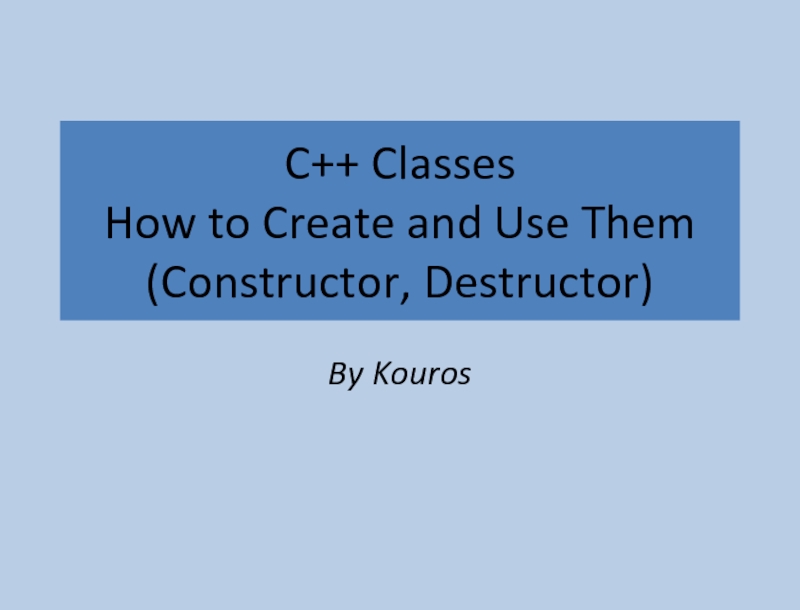
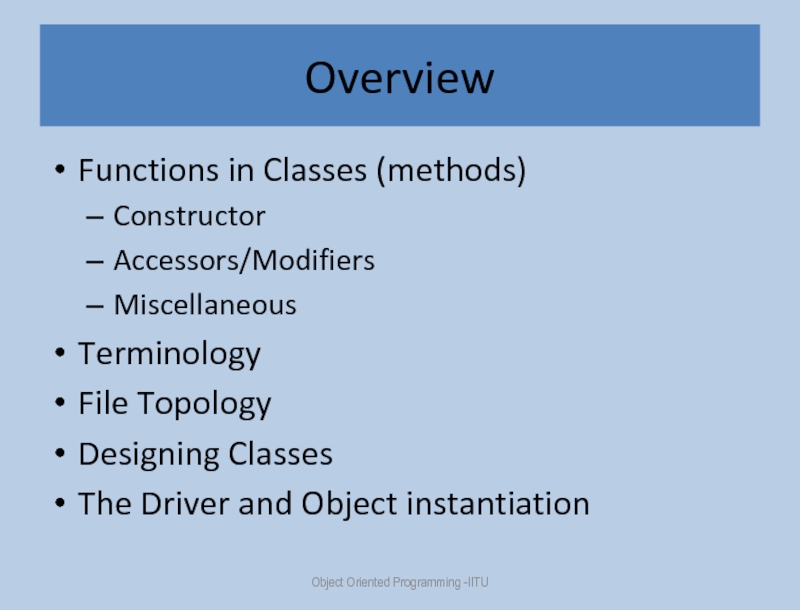
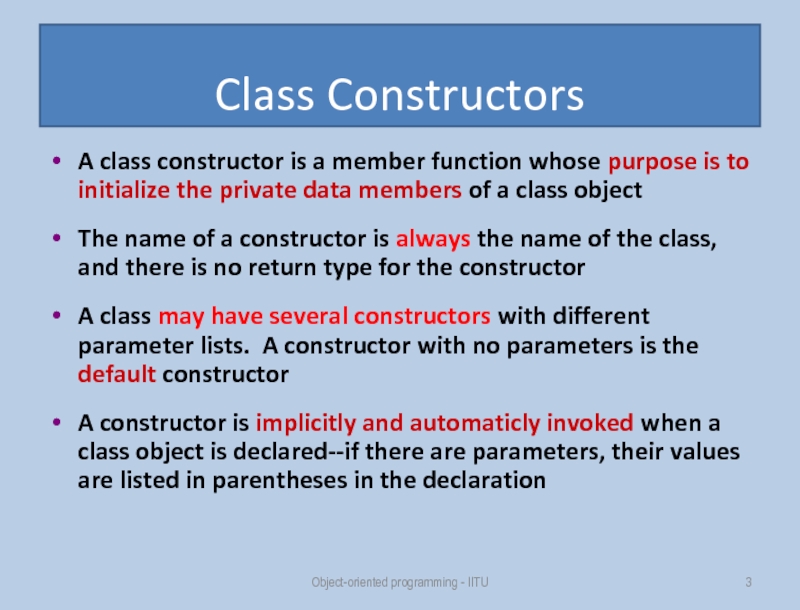
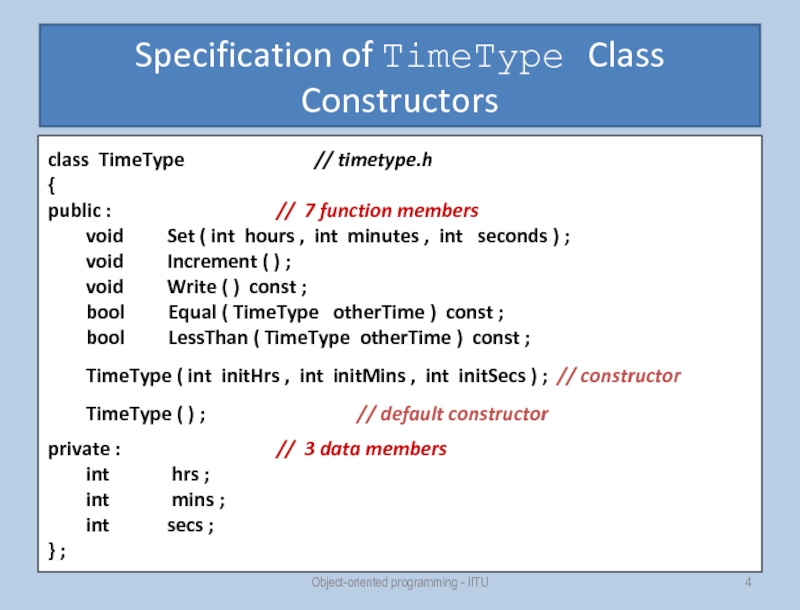
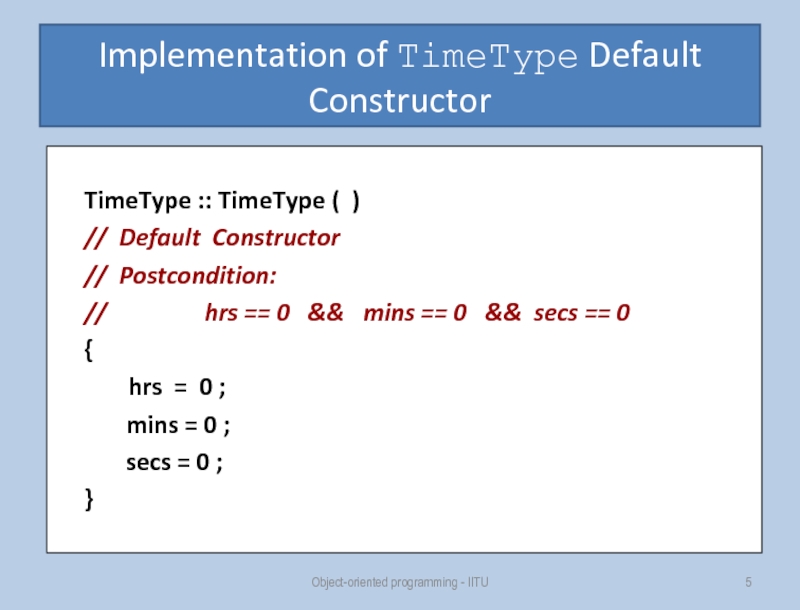
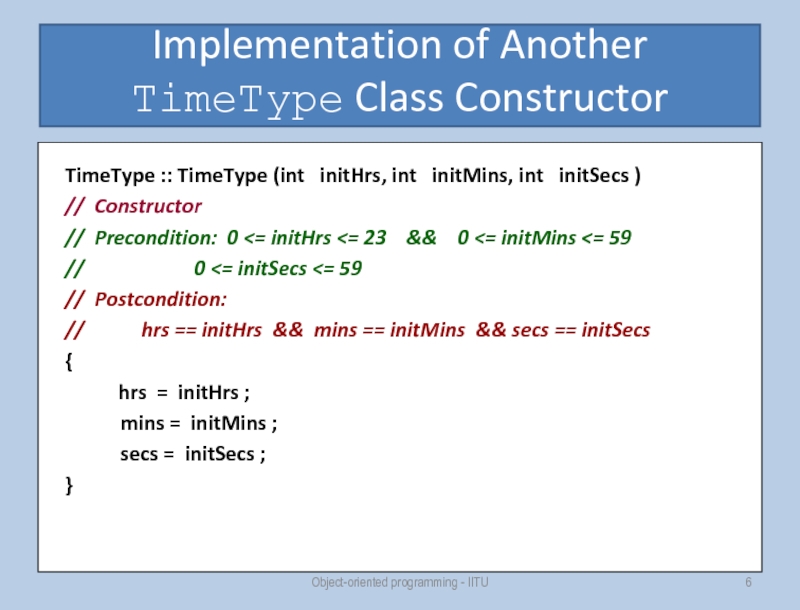
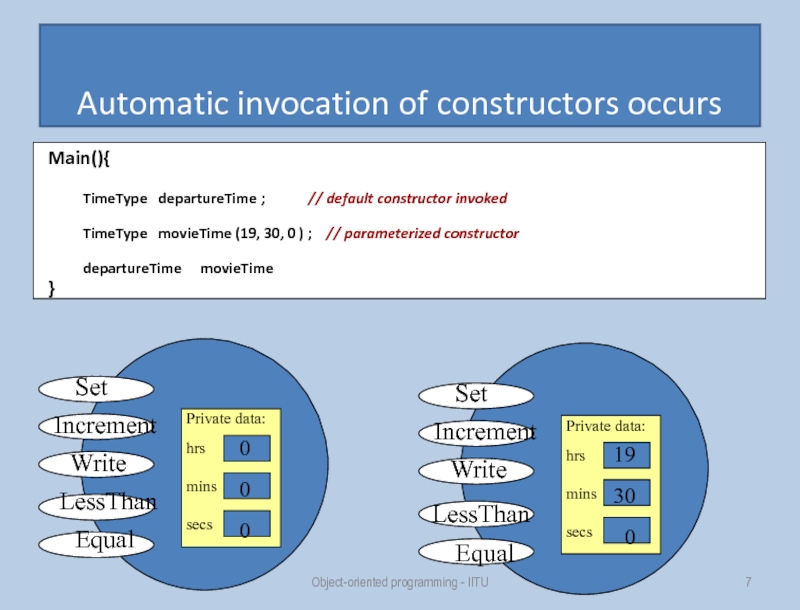
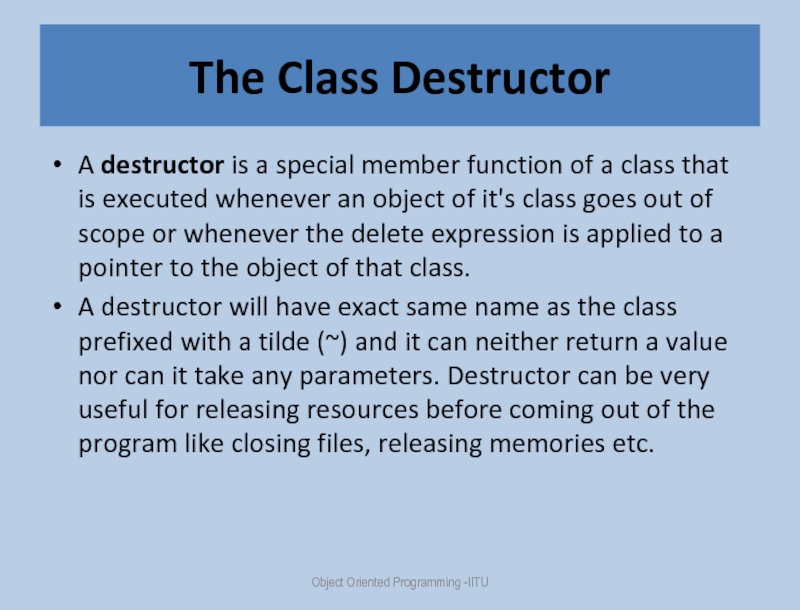
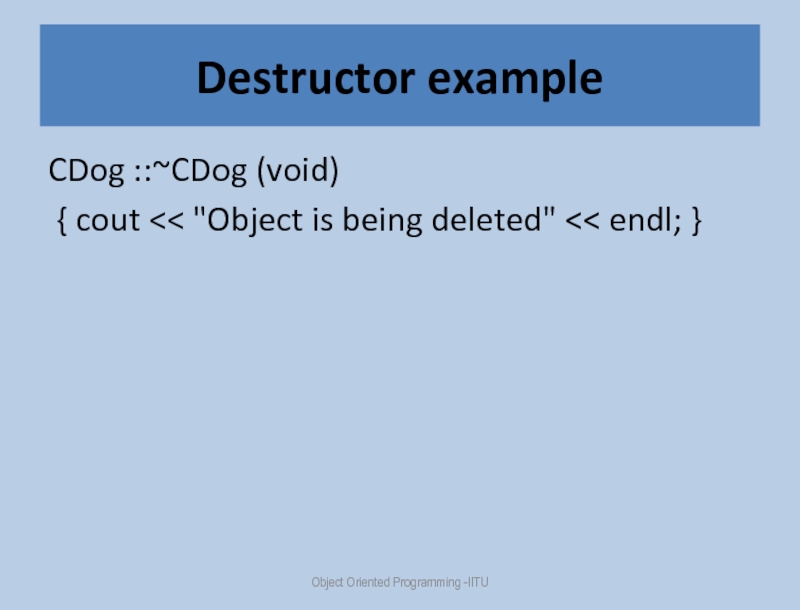
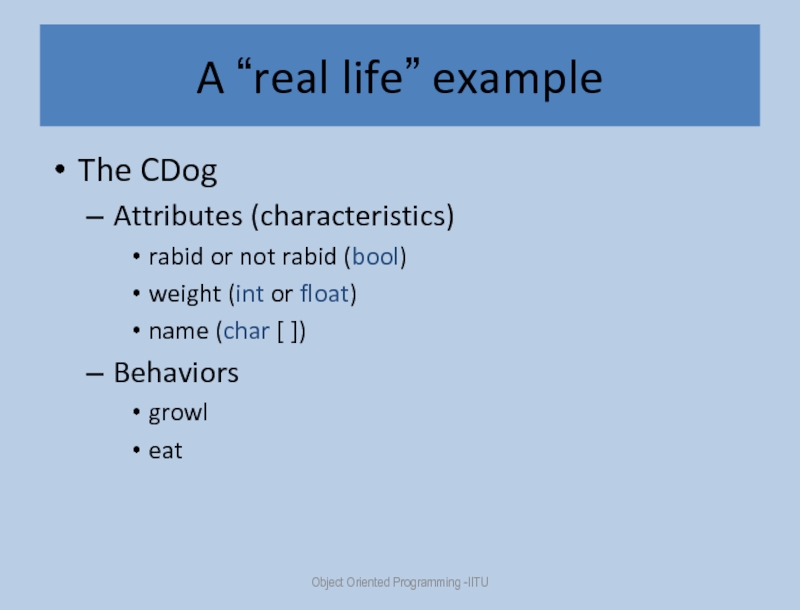
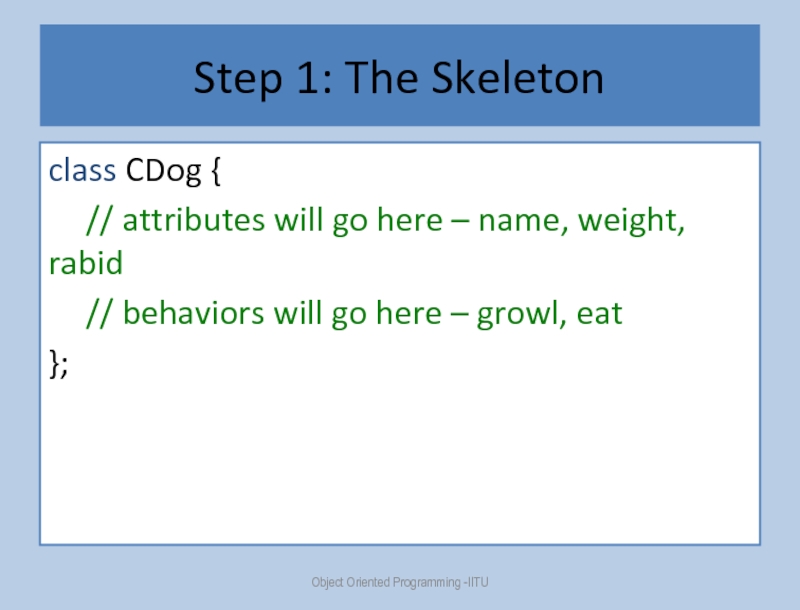
![Step 2: The attributes class CDog { public: boolean rabid; int weight; char name[255]; // Behaviors go here};Object](/img/tmb/4/334800/c50889f86a12bb2497cd83c97a5e513c-800x.jpg)
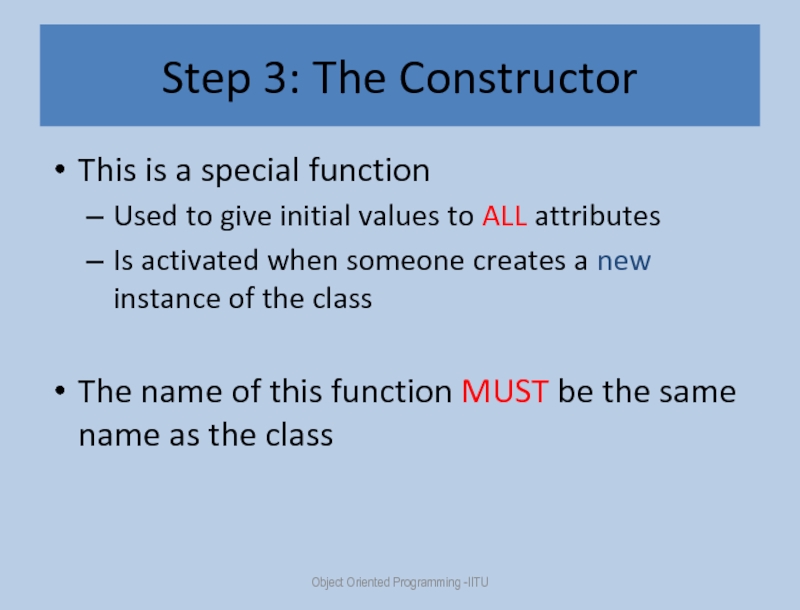
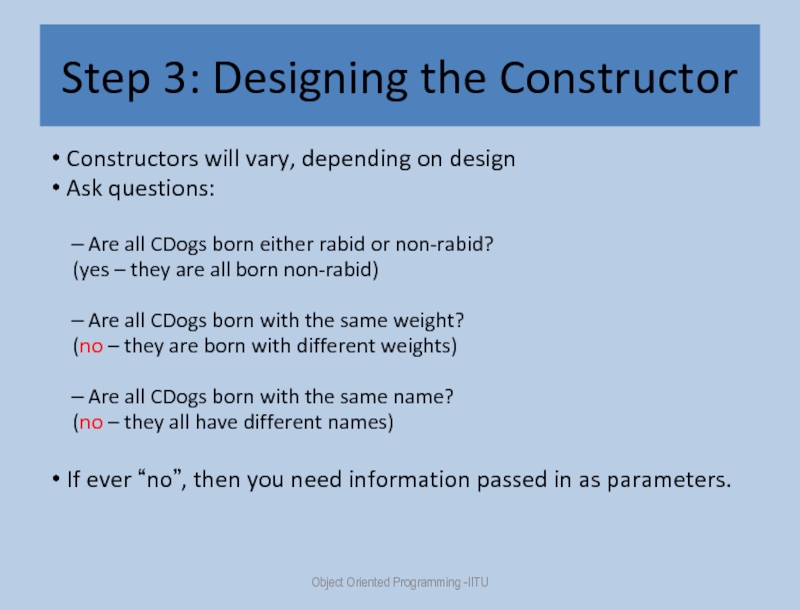
![Step 3: The Constructorclass CDog { public: boolean rabidOrNot; int weight; char name [255]; // Constructor CDog::CDog (int x, String y)](/img/tmb/4/334800/381b679c460be8cf0b1fdad534a1f0a1-800x.jpg)
![Back to CDogclass CDog { public: boolean rabidOrNot; int weight; char name [255]; // Constructor CDog::CDog (int x, char y[ ])](/img/tmb/4/334800/aef63d9a1ffc026147c3b30a8e9a67f6-800x.jpg)

![Add Methodsclass CDog { public: boolean rabidOrNot; int weight; char name [255]; // Constructor CDog::CDog (int x, char y[ ]) { rabid](/img/tmb/4/334800/dcdb743e3b9b144ebee3034aee271e45-800x.jpg)

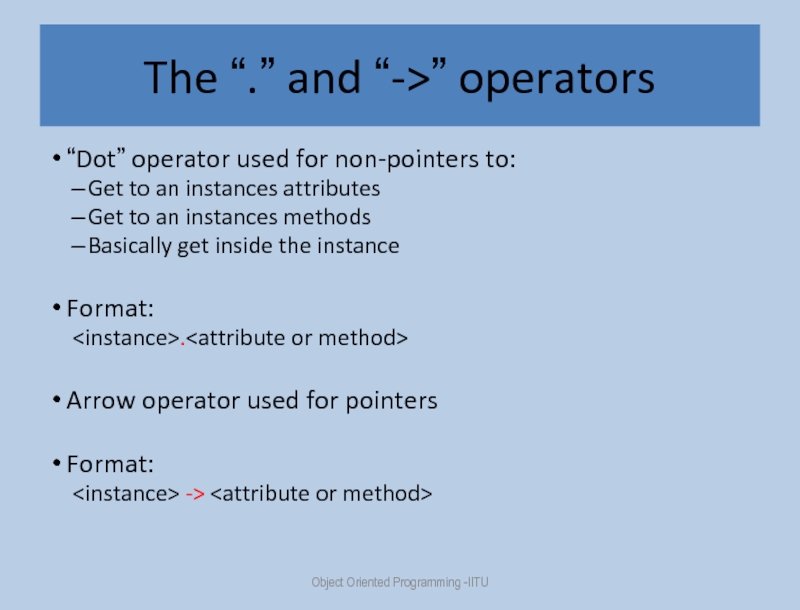
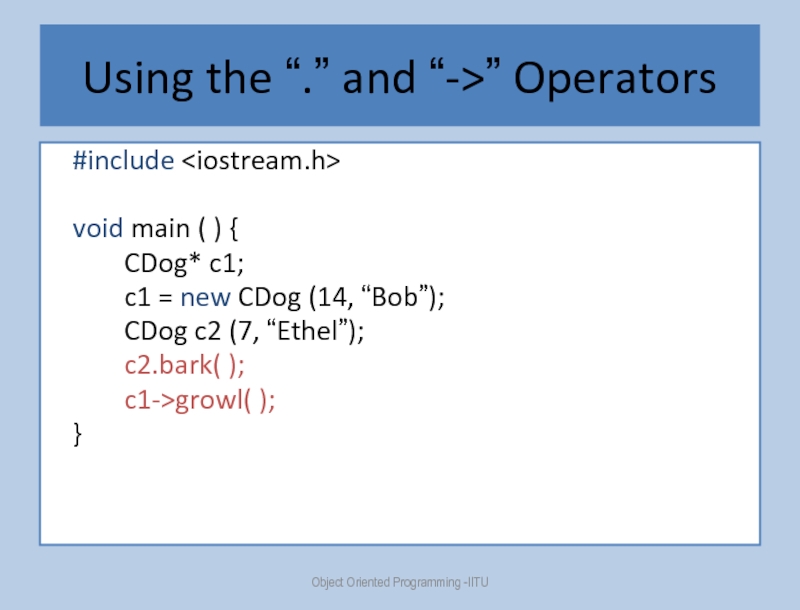
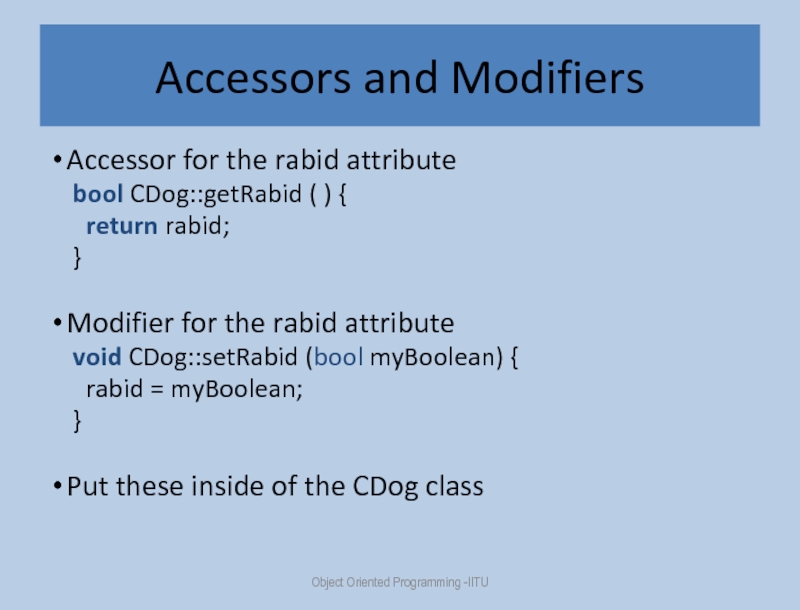
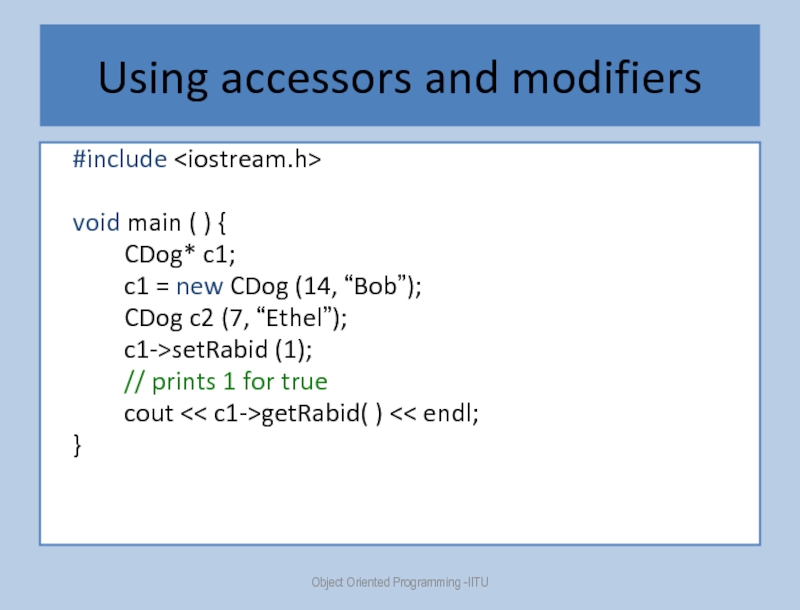
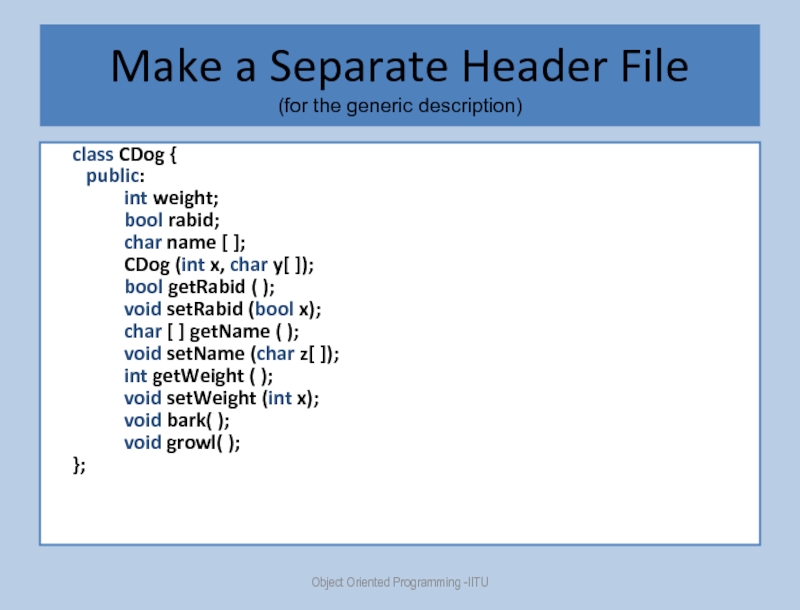
![Our Final CDog.cpp #include #include // Constructor CDog::CDog (int x, char y[ ]) { rabid](/img/tmb/4/334800/dbec13fbe637195b66b3a843d08486a8-800x.jpg)
